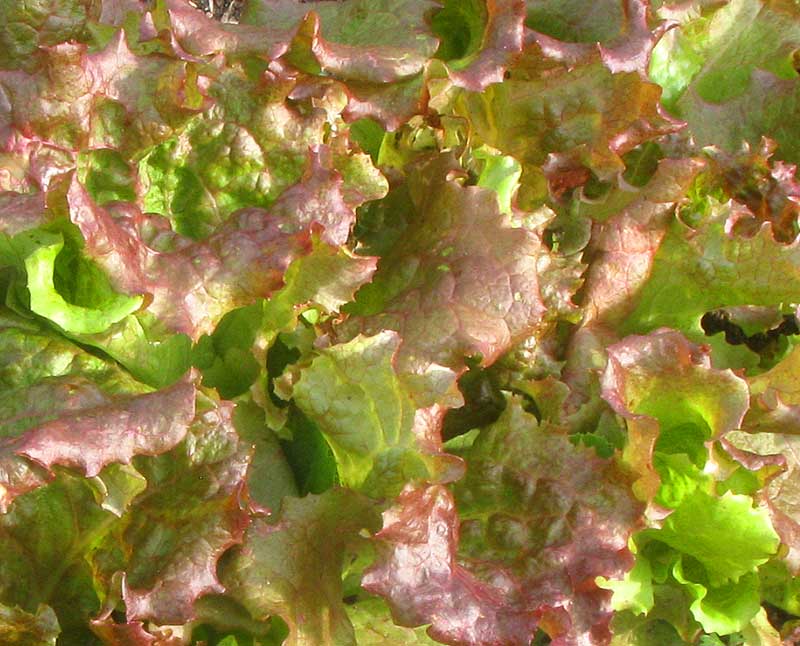Excerpts from Jim Conrad's
Naturalist Newsletter

from the December 23, 2012 Newsletter issued from the valley of the Dry Frio River in northern Uvalde County, southwestern Texas, on the southern border of the Edwards Plateau; elevation ~1750m (~5750 ft); N29.62°, W99.86°; USA
LETTUCE
Especially on cold mornings when sunlight pours in from the east with its special edge-of-desert intensity and sharpness, the lettuce is so pleasing to look at, its frilly, tender leaves glowing with yellow-greenness and burgundy shades, as shown above.
Our first freeze of the season sneaked up on me so I hadn't properly covered the lettuce bed the night of the freeze. That morning the lettuce was hoary with frost and I thought that by the afternoon it'd be brown and soggy, but the freeze didn't seem to hurt it at all. In fact, studies show that while many cultivated plants such as potato, corn and tobacco can't survive freezes, leaves of plants such as cabbage, lettuce, and spinach can develop tolerance to below-freezing temperatures in response to recent low but above-freezing temperatures. We'd had some cold nights prior to the first freeze, so that must have induced freeze tolerance for my lettuce on the freezing night. One way that gradually lowering temperatures over a period of days can produce freeze tolerance is to cause plants to lower their water content and develop thicker leaves.
If you've seen the yellow, Dandelion-like flowers and fruits of lettuce that's gone to seed, you probably recognized that lettuce is a member of the Composite or Sunflower Family. Many kinds of lettuce exist, all with the binomial LACTUCA SATIVA. Traditionally four taxonomic varieties of Lactuca sativa have been recognized: capitata, with its head lettuce; longifolia, with its romaine lettuce; crispa, with its curled-leaf lettuce, and; asparagina, with its thick, edible stems.
Our picture shows a curled lettuce of the variety crispa. It's further distinguished as a "red leaf lettuce," and there are several different cultivars of red leaf lettuce on the market. You might enjoy looking at the numerous lettuce cultivars illustrated on Dave's Garden Lettuce Page at https://davesgarden.com/guides/pf/finder/index.php?sname=Lettuce.
Lettuce's history of cultivation has been nicely documented. Egyptians first domesticated it not for its edible leaves but for oil from its seeds, then later selectively bred it for its leaves. There's evidence of its cultivation in Egypt as early as 2680 BC. From Egypt lettuce was passed to ancient Greece and then to the Romans, who already by 50 AD were able to describe several lettuce varieties. By the 1500s Europeans were recognized the basic leaf-lettuce types -- head, loose-leaf and romaine. Columbus himself introduced lettuce in the Americas. By the late 1800s between 65 and 140 distinct kinds of lettuce were recognized.